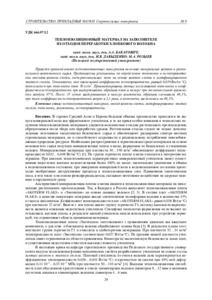Please use this identifier to cite or link to this item:
https://elib.psu.by/handle/123456789/24667Full metadata record
| DC Field | Value | Language |
|---|---|---|
| dc.contributor.author | Бакатович, А. А. | - |
| dc.contributor.author | Давыденко, Н. В. | - |
| dc.contributor.author | Розыев, М. А. | - |
| dc.contributor.author | Bakatovich, A. | - |
| dc.contributor.author | Rozyyev, M. | - |
| dc.contributor.author | Davydenko, N. | - |
| dc.date.accessioned | 2020-04-30T07:18:26Z | - |
| dc.date.available | 2020-04-30T07:18:26Z | - |
| dc.date.issued | 2019 | - |
| dc.identifier.citation | Бакатович, А. А. Теплоизоляционный материал на заполнителе из отходов переработки хлопкового волокна / А. А. Бакатович, Н. В. Давыденко, М. А. Розыев // Вестник Полоцкого государственного университета. Серия F, Строительство. Прикладные науки. - 2019. - № 8. - С. 29-33. | ru_RU |
| dc.identifier.issn | 2070-1683 | - |
| dc.identifier.uri | https://elib.psu.by/handle/123456789/24667 | - |
| dc.description.abstract | Приведен краткий анализ теплоизоляционных материалов на основе минеральных волокон и растительного волокнистого сырья. Представлены результаты по определению плотности и теплопроводности отходов волокна хлопка, экспериментальных плит на основе волокон хлопка и модифицированного жидкого стекла. Установлено, что наименьший коэффициент теплопроводности, равный 0,039 Вт/(м·°С), достигается при плотности плит 58 кг/м3. Проанализированы данные исследований плотности и коэффициента теплопроводности при выдерживании образцов плит в камере при относительной влажности воздуха 97%. После 35 суток выдерживания в камере влажность образцов составила 48,1%, при этом коэффициент теплопроводности возрос в 2,1 раза, а плотность увеличилась на 48,3%.= A brief analysis of heat-insulating materials based on mineral fibers and plant fiber raw materials is given. the results of determining the density and thermal conductivity of waste cotton fiber, experimental plates based on cotton fibers and modified water glass are presented. It was found that the lowest thermal conductivity coefficient equal to 0.039 W/(m·°С) is achieved at a plate density of 58 kg/m3. the data of studies of the density and coefficient of thermal conductivity during aging of plate samples in the chamber at a relative humidity of 97% are analyzed. After 35 days in the chamber, the humidity of the samples is 48.1%, while the coefficient of thermal conductivity increases by 2.1 times, and the density increases by 48.3%. | ru_RU |
| dc.language.iso | ru | ru_RU |
| dc.publisher | Полоцкий государственный университет | ru_RU |
| dc.relation.ispartof | Веснік Полацкага дзяржаўнага ўніверсітэта. Серыя F, Будаўніцтва. Прыкладныя навукі | be_BE |
| dc.relation.ispartof | Herald of Polotsk State University. Series F, Civil engineering. Applied sciences | en_EN |
| dc.relation.ispartof | Вестник Полоцкого государственного университета. Серия F. Строительство. Прикладные науки | ru_RU |
| dc.relation.ispartofseries | Серия F. Строительство. Прикладные науки;2019. - № 8 | - |
| dc.rights | open access | ru_RU |
| dc.subject | Государственный рубрикатор НТИ - ВИНИТИ::ТЕХНИЧЕСКИЕ И ПРИКЛАДНЫЕ НАУКИ. ОТРАСЛИ ЭКОНОМИКИ::Строительство. Архитектура | ru_RU |
| dc.subject | Теплоизоляционный материал | ru_RU |
| dc.subject | Отход волокна хлопка | ru_RU |
| dc.subject | Модифицированное жидкое стекло | ru_RU |
| dc.subject | Плотность | ru_RU |
| dc.subject | Влажность | ru_RU |
| dc.subject | Теплопроводность | ru_RU |
| dc.subject | Heat-insulating material | ru_RU |
| dc.subject | Cotton fiber waste | ru_RU |
| dc.subject | Modified water glass | ru_RU |
| dc.subject | Density | ru_RU |
| dc.subject | Humidity | ru_RU |
| dc.subject | Thermal conductivity | ru_RU |
| dc.title | Теплоизоляционный материал на заполнителе из отходов переработки хлопкового волокна | ru_RU |
| dc.title.alternative | Insulating Material on a Filler From Cotton Fiber Processing Waste | ru_RU |
| dc.type | Article | ru_RU |
| dc.identifier.udc | 666.973.2 | - |
| Appears in Collections: | 2019, № 8 | |
Items in DSpace are protected by copyright, with all rights reserved, unless otherwise indicated.
